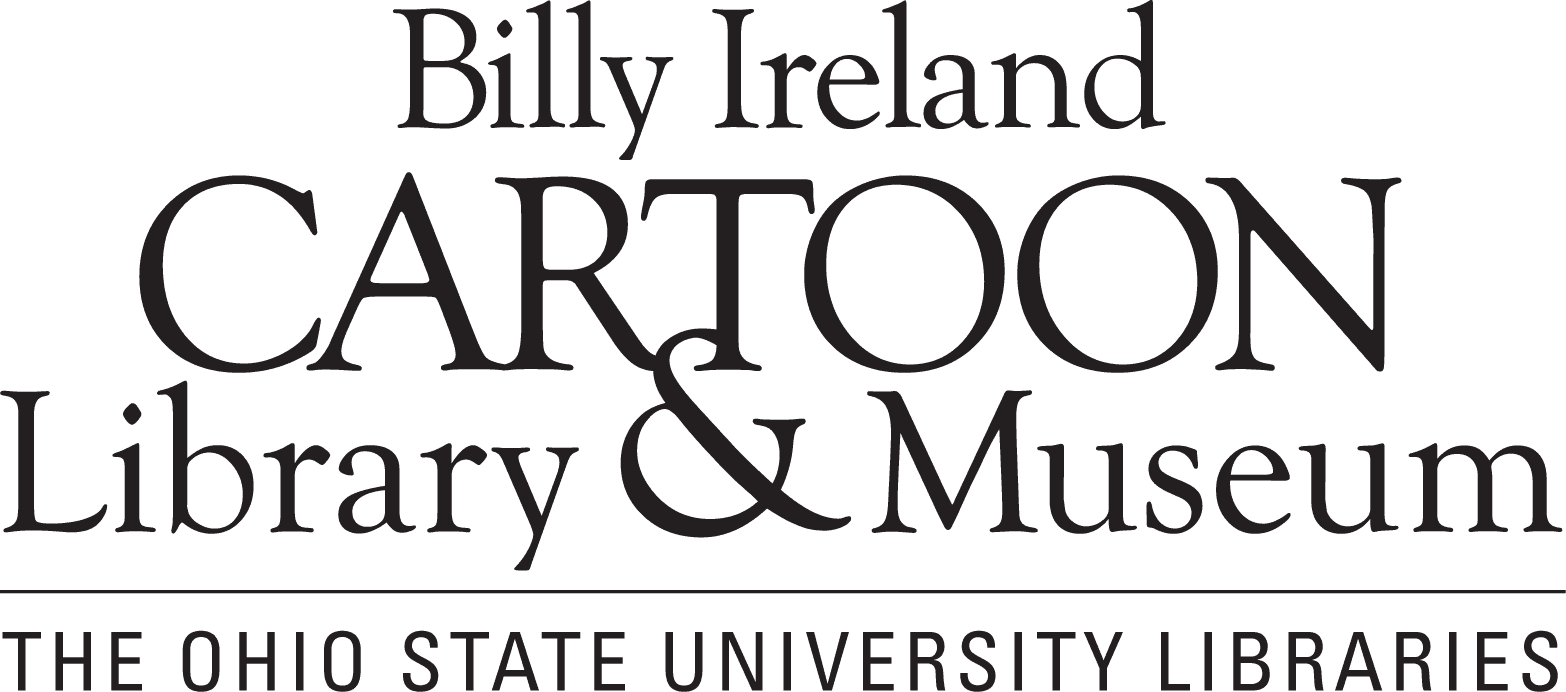Nhora Serrano is a Visiting Assistant Professor of Comparative Literature at Hamilton College in New York. She recently spent a week looking at art, magazines, and tear sheets in our Lucy Shelton Caswell Reading Room. We sat down with Nhora to find out more about her research and experience at the Billy Ireland.
What brought you to the Billy Ireland?
I am here for two reasons. First, I received a curricular fellowship from Hamilton College’s Levitt Center: the Social Innovation and Transformational Leadership Course Development Grant. This fellowship is helping me develop a new course in the spring, focused on immigrants in comics. The second reason I am here is to do research on my own projects, and to take advantage of my time here.
“Immigrants in Comics” sounds like a fascinating class—can you tell us more about your research for it?
Well of course, I have spent a lot of time in the current exhibit, Looking Backward, Looking Forward: U.S. Immigration in Cartoons and Comics (on display until April 22). I’ve also been spending a lot of time looking through Puck Magazine to find representations of immigrants, as well as Judge, Wasp, and other publications that include early editorial cartoons.
Will you be mostly focusing on editorial cartoons?
We will begin by looking at editorial cartoons, but we will also be looking at comic strips and graphic novels, to approach the topic from a range of formats. I felt that it was important to introduce students to early comics before graphic novels, to give them a history of the medium. I’m taking advantage of the Billy Ireland’s great collection of [Gus Arriola’s comic strip] Gordo to understand representations of latinx characters in comics. Arriola was the first latinx cartoonist to really engage with these representations.

“This Gordo strip by Gus Arriola is a meta-reference to what happens to a newspaper strip when the artist falls ill.” Gus Arriola and Eldon Dedini, Gordo, 1958. From the Eldon Dedini Collection.
I’m also going to teach Lila Quintero Weaver’s Darkroom: A Memoir in Black and White, an Argentinian-American’s memoir about immigrating to Alabama on the cusp of the Civil Rights movement. (The current Looking Backward, Looking Forward exhibit features original art from the book).
And what have you been looking at for your personal research?
My interest is in early editorial cartoons, and my current research is focused on the figure of Columbia. From the turn of the century all the way through the 1940’s, Columbia was comparable to the U.K.’s figure of Britannia. She sometimes appears next to Uncle Sam, or with symbols of other countries. I’m trying to investigate her significance: the figure of a woman representing a country or state is common, but the fact that this representation has disappeared since the 1940’s is interesting to me.

“USA and Canada are represented as women. Is this USA also Columbia?” Puck Vol. XXXII, September 7th, 1892. From the Billy Ireland Cartoon Library & Museum Collection.
Have you found anything unexpected in your research?
Well, this [image below] is a curious find: This is the ‘centerfold’ of an 1890 issue. The image shows the states as women. More importantly, on the left-hand side are visual echoes to two paintings: (1) Manet’s Le Déjeuner sur l’herbe (1862) (this may be somewhat of a stretch, but there are visual resonances here that I still need to unpack); and (2) Jean-Honoré Fragonard’s Les Hasards heureux de l’escarpolette (1767) (the swing with Idaho in the upper left-hand corner). The art world is ever present in these early cartoonists’ minds and toolbox.
What will your research on Columbia be used for?
I’m working on an article on Columbia and turn-of-the-century editorial cartoons for an anthology. I’m also hoping to make this part of a monograph, on the combination of Columbia and the 1893 World’s Fair.
Any highlights from visiting the city of Columbus (food, stores, bars, museums, etc)?
My time is limited, so I usually just go back to the hotel in the evenings to work on what I’m doing! But while I’m at the Billy Ireland, I love the fact you have Heirloom Café (in the Wexner Center for the Arts), which is close enough to grab a quick lunch and come back. It’s actually my third time here; I presented a paper at both ICAF (International Comic Arts Forum) in 2014 and CXC (Cartoon Crossroads Columbus) in 2015.

Centerfold of Puck No. 698, July 23, 1890. From the Billy Ireland Cartoon Library & Museum Collection.




Recent Comments